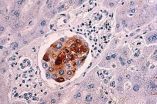(Press-News.org) By following certain rules, scientists can prepare architectural plans for building ideal protein molecules not found in the real world. Based on these computer renditions, previously non-existent proteins can be produced from scratch in the lab. The principles to make this happen appear this month in Nature magazine.
The lead authors are Dr. Nobuyasu Koga and Dr. Rie Tatsumi-Koga, a husband-and-wife scientific team in Dr. David Baker's lab at the University of Washington Protein Design Institute.
The project benefited from hundreds of thousands of computer enthusiasts around the world who adopted Rosetta@home for simulating designed proteins.
Protein molecules start as an unstable, high energy chain of amino acids. This chain then begins folding into various shapes to try to achieve a stable, low energy state. The end result is its distinctive molecular structure. Rosetta@home volunteers helped the project team to plot this energy landscape from protein structure predictions.
"The structural options become fewer as the interactions that stabilize the protein selectively favor one folding pattern over others," explained Koga.
"This decline in conformation options to eventually achieve a unique, ordered structure is called a funnel-shaped energy landscape," he said, drawing a tornado-like figure on a whiteboard. The researchers came up with guidelines for robustly generating this type of energy landscape.
According to Tatsumi-Koga, these rules require the interactions among the residues in the protein's amino acid chain to consistently favor the same folded conformation in forming its molecular shape. This is made possible, for example, by defining whether a specific unit will form a "right-handed" orientation or its mirror image, and disfavor others.
The researchers, she said, synthesized the proteins they had originally designed and tested "in silico" (on the computer) and physically characterized them through "in vitro" (laboratory test tube) experiments.
They also compared the molecular structures of the computer models with these laboratory-derived proteins to see how well they matched.
Koga stressed that the project looked strictly at protein structure. He smiled as he said his group was striving toward a "platonic ideal," a reference to Plato's theory of perfect forms.
In our imperfect material world, proteins are not always optimized for their stability, but can be beset by bulges, kinks, strains, and improperly buried parts. Many diseases arise from protein malformations.
During this project, the researchers achieved a library of five ideal structures, but since filing their report have added several more.
To make them accessible to other scientists, the designs have been deposited in the Research Collaboratory for Structural Bioinformatics and the lab analysis of their chemical structure was put in the Biological Magnetic Resonance Database.
The team was not attempting to create specific new proteins that could carry out particular activities.
However, their design principles and methods, according to their report, should allow the ready creation of a wide range of robust, stable, building blocks for the next generation of engineered functional proteins.
Such proteins would be custom-made for the task, instead of repurposed from proteins with unrelated functions. The hope is that engineered proteins will be useful for drug and vaccine development, especially for formidable viruses like HIV or rapidly changing ones, like the flu.
Proteins designed to exact specifications might also prove therapeutically useful in cleaving mutated genes, and for speeding up chemical reactions important in industry and environmental reclamation.
INFORMATION:
The Institute for Protein Design, directed by David Baker, was recently established at the UW and aims to design proteins to address 21st century challenges in medicine, energy and technology.
The project, Principles for designing ideal protein structures, was funded by the Howard Hughes Medical Institute, the U.S. Department of Energy, the Defense Advanced Research Projects Agency, the Defense Threat Reduction Agency, and the National Institute of General Medical Sciences, NIH grant U54 GMO94597. Koga also received a postdoctoral research fellowship from the Japan Society for the Promotion of Science.
The researchers declared no competing financial interests.
Rules devised for building ideal protein molecules from scratch
By following a set of principles, scientists can produce protein molecules that previously did not exist in nature
2012-11-29
ELSE PRESS RELEASES FROM THIS DATE:
Most of the harmful mutations in people arose in the past 5,000 to 10,000 years
2012-11-29
A study dating the age of more than 1 million single-letter variations in the human DNA code reveals that most of these mutations are of recent origin, evolutionarily speaking. These kinds of mutations change one nucleotide – an A, C, T or G – in the DNA sequence. Over 86 percent of the harmful protein-coding mutations of this type arose in humans just during the past 5,000 to 10,000 years.
Some of the remaining mutations of this nature may have no effect on people, and a few might be beneficial, according to the project researchers. While each specific mutation is ...
Alcoholic fly larvae need fix for learning
2012-11-29
Fly larvae fed on alcohol-spiked food for a period of days grow dependent on those spirits for learning. The findings, reported in Current Biology, a Cell Press publication, on November 29th, show how overuse of alcohol can produce lasting changes in the brain, even after alcohol abuse stops.
The report also provides evidence that the very human experience of alcoholism can be explored in part with studies conducted in fruit flies and other animals, the researchers say.
"Our evidence supports the long-ago proposed idea that functional ethanol tolerance is produced by ...
Hand use improved after spinal cord injury with noninvasive stimulation
2012-11-29
By using noninvasive stimulation, researchers were able to temporarily improve the ability of people with spinal cord injuries to use their hands. The findings, reported on November 29th in Current Biology, a Cell Press publication, hold promise in treating thousands of people in the United States alone who are partially paralyzed due to spinal cord injury.
"This approach builds on earlier work and highlights the importance of the corticospinal tract—which conducts impulses from the brain's motor cortex to the spinal cord and is a major pathway contributing to voluntary ...
Traffic cops of the immune system
2012-11-29
This press release is available in German.
Now, scientists at the Helmholtz Centre for Infection Research (HZI) have looked into the origin of Tregs and uncovered a central role played by the protein IkBNS. Armed with this knowledge, the researchers hope to manipulate Tregs in order to either inhibit or activate the immune system. Biochemist Prof. Ingo Schmitz and his team have now published their findings in the scientific journal Immunity.
The immune system is a complex network of different types of cells and chemical messengers. The regulatory cells and other immune ...
UW-Madison scientists create roadmap to metabolic reprogramming for aging
2012-11-29
MADISON – In efforts to understand what influences life span, cancer and aging, scientists are building roadmaps to navigate and learn about cells at the molecular level.
To survey previously uncharted territory, a team of researchers at UW-Madison created an "atlas" that maps more than 1,500 unique landmarks within mitochondria that could provide clues to the metabolic connections between caloric restriction and aging.
The map, as well as the techniques used to create it, could lead to a better understanding of how cell metabolism is re-wired in some cancers, age-related ...
Study helps resolve debate about how tumors spread
2012-11-29
A team of scientists, led by researchers at the University of California, San Diego School of Medicine, has shown for the first time how cancer cells control the ON/OFF switch of a program used by developing embryos to effectively metastasize in vivo, breaking free and spreading to other parts of the body, where they can proliferate and grow into secondary tumors.
The findings are published in the December 11 issue of the journal Cancer Cell.
In 90 percent of cancer deaths, it is the spreading of cancer, known as metastasis, which ultimately kills the patient by impacting ...
Study sheds light on how pancreatic cancer begins
2012-11-29
A diagnosis of pancreatic cancer is particularly devastating since the prognosis for recovery is usually poor, with the cancer most often not detected until late stages.
Research led by scientists at the University of California, San Diego and UC San Francisco Schools of Medicine examined the tumor-initiating events leading to pancreatic cancer (also called pancreatic ductal adenocarcinoma or PDA) in mice. Their work, published on line November 29 in the journal Cancer Cell, may help in the search for earlier detection methods and treatments.
"Previously, it was believed ...
Short-term exposure to essential oils lowers blood pressure and heart rate
2012-11-29
The scents which permeate our health spas from aromatic essential oils may provide more benefits than just a sense of rest and well-being.
For according to a new study(1) in the European Journal of Preventive Cardiology, the essential oils which form the basis of aromatherapy for stress relief are also reported to have a beneficial effect on heart rate and blood pressure following short-term exposure - and may therefore reduce the risk of cardiovascular disease. However, on the downside, those beneficial effects were reversed when exposure to essential oils lasted more ...
Prenatal exposure to testosterone leads to verbal aggressive behavior
2012-11-29
Washington, DC (November 27, 2012) –A new study in the Journal of Communication links verbal aggression to prenatal testosterone exposure. The lead researcher, at University at Buffalo – The State University of New York, used the 2D:4D measure to predict verbal aggression. This study is the first to use this method to examine prenatal testosterone exposure as a determinant of a communication trait.
Allison Z. Shaw, University at Buffalo – The State University of New York, Michael R. Kotowski, University of Tennessee, and Franklin J. Boster and Timothy R. Levine, Michigan ...
Enzyme inhibition protects against Huntington's disease damage in 2 animal models
2012-11-29
Treatment with a novel agent that inhibits the activity of SIRT2, an enzyme that regulates many important cellular functions, reduced neurological damage, slowed the loss of motor function and extended survival in two animal models of Huntington's disease. The study led by Massachusetts General Hospital (MGH) researchers will appear in the Dec. 27 issue of Cell Reports and is receiving advance online release.
"I believe that the drug efficacy demonstrated in two distinct genetic HD mouse models is quite unique and highly encouraging," says Aleksey Kazantsev, PhD, of ...
LAST 30 PRESS RELEASES:
New software sheds light on cancer’s hidden genetic networks
UT Health San Antonio awarded $3 million in CPRIT grants to bolster cancer research and prevention efforts in South Texas
Third symposium spotlights global challenge of new contaminants in China’s fight against pollution
From straw to soil harmony: International team reveals how biochar supercharges carbon-smart farming
Myeloma: How AI is redrawing the map of cancer care
Manhattan E. Charurat, Ph.D., MHS invested as the Homer and Martha Gudelsky Distinguished Professor in Medicine at the University of Maryland School of Medicine
Insilico Medicine’s Pharma.AI Q4 Winter Launch Recap: Revolutionizing drug discovery with cutting-edge AI innovations, accelerating the path to pharmaceutical superintelligence
Nanoplastics have diet-dependent impacts on digestive system health
Brain neuron death occurs throughout life and increases with age, a natural human protein drug may halt neuron death in Alzheimer’s disease
SPIE and CLP announce the recipients of the 2025 Advanced Photonics Young Innovator Award
Lessons from the Caldor Fire’s Christmas Valley ‘Miracle’
Ant societies rose by trading individual protection for collective power
Research reveals how ancient viral DNA shapes early embryonic development
A molecular gatekeeper that controls protein synthesis
New ‘cloaking device’ concept to shield sensitive tech from magnetic fields
Researchers show impact of mountain building and climate change on alpine biodiversity
Study models the transition from Neanderthals to modern humans in Europe
University of Phoenix College of Doctoral Studies releases white paper on AI-driven skilling to reduce burnout and restore worker autonomy
AIs fail at the game of visual “telephone”
The levers for a sustainable food system
Potential changes in US homelessness by ending federal support for housing first programs
Vulnerability of large language models to prompt injection when providing medical advice
Researchers develop new system for high-energy-density, long-life, multi-electron transfer bromine-based flow batteries
Ending federal support for housing first programs could increase U.S. homelessness by 5% in one year, new JAMA study finds
New research uncovers molecular ‘safety switch’ shielding cancers from immune attack
Bacteria resisting viral infection can still sink carbon to ocean floor
Younger biological age may increase depression risk in older women during COVID-19
Bharat Innovates 2026 National Basecamp Showcases India’s Most Promising Deep-Tech Ventures
Here’s what determines whether your income level rises or falls
SCIE indexation achievement: Celebrate with Space: Science & Technology
[Press-News.org] Rules devised for building ideal protein molecules from scratchBy following a set of principles, scientists can produce protein molecules that previously did not exist in nature





